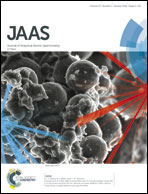Atomic spectrometry update – a review of advances in environmental analysis
Abstract
This is the 33th annual review of the application of atomic spectrometry to the chemical analysis of environmental samples. This update refers to papers published approximately between August 2016 and June 2017 and continues the series of Atomic Spectrometry Updates (ASUs) in environmental analysis that should be read in conjunction with other related ASUs in the series, namely: clinical and biological materials, foods and beverages; advances in atomic spectrometry and related techniques; elemental speciation; X-ray spectrometry; and metals, chemicals and functional materials. In the field of air analysis, highlights within this review period included the fabrication of new air samplers using 3D printer technology, development of a portable aerosol concentrator unit based upon electrostatic precipitation and instrumental developments such as a prototype portable spark emission spectrometer to quantify metal particles in workplace air. The advent of ICP-MS/MS systems has enabled analysts to develop improved methods for the determination of PGEs and radioactive elements present in airborne particles. With such instruments, the capacity to eliminate or minimise many isobaric interferences now enables analysts to forego the use of many onerous sample clean-up procedures. Improvements in the capabilities of aerosol mass spectrometers were noted as were developments in other complimentary measurement techniques such as Raman. In the arena of water analysis there are growing concerns regarding engineered NPs e.g. Ag NPs, entering water courses resulting in the development and optimisation of new methods based upon FFF and sp-ICP-MS techniques to measure such inputs. Similar concerns exist for MRI contrasting agents e.g. Gd-based compounds and here improved methodologies that involve the use of sample preconcentration using chelating columns and ICP-MS analysis have been proposed. In the field of plant and soil analysis, similar to developments in the water sector, there has been increased interest in the measurement of NPs. Many comparisons of sample digestion or extraction methods have been reported but a key issue rarely addressed is transferability, i.e. whether methods preferred by one group of researchers using particular apparatus are also optimal in a different laboratory using different apparatus. New sample preconcentration methods continued to appear although – as in previous years – the CRMs selected for method validation often failed to reflect the nature of the intended sample(s). A noteworthy advance is the use of HR-CS-ETMAS for elemental analysis. Developments in LIBS included greater use of TEA CO2 lasers in place of Nd:YAG lasers and increased use of stand-off measurement. The past year has also seen a rise in proximal sensing using LIBS and pXRFS. In the field of geological analysis, the quest continues for well-characterised matrix-matched materials suitable for the calibration of elemental and, particularly, isotopic measurements by microanalytical techniques. Increasing interest in stable isotope analysis by SIMS is reflected by the number of matrix-matched RMs developed specifically for this technique. Much work continues on ways of improving isotope ratio measurements by ICP-MS and TIMS for a wide range of different isotope systems relevant to geochemical studies. High spatial resolution analysis by LIBS, LA-ICP-MS and SIMS to obtain data on chemical and isotopic variations in minerals and biogenic materials in two and three dimensions are the foundation for many new insights in geoscientific research. In XRFS and LIBS, the advantages and limitations of portable instrumentation continue to be major focus of activity.

- This article is part of the themed collections: Atomic Spectrometry Updates and JAAS 2018 Most Downloaded Articles


 Please wait while we load your content...
Please wait while we load your content...